 |
||||||||||||||||||||||
|
||||||||||||||||||||||
 |
||||||
|
|
||||||
|
This interview with Lasse
Pihlajamaa was conducted at his home in Espoo, Finland (outside Helsinki)
on June 28, 2004.
Sincerely, 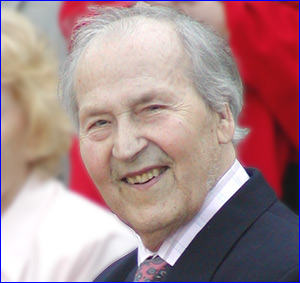 Lasse
Pihlajamaa (b. 1916) is a Finnish accordionist, composer-arranger, teacher,
entertainer and world-class accordion comedian and father of a range of
accordion models. Lasse
Pihlajamaa (b. 1916) is a Finnish accordionist, composer-arranger, teacher,
entertainer and world-class accordion comedian and father of a range of
accordion models.Lasse Pihlajamaa has had an exceptionally far-ranging career. For over 60 years, he has been the pioneer of Finnish accordion music. As a composer he was searching for the musical and technical limits of the instrument as early as the 1940's, when 'The Dance of the Wind', 'The Dragonfly', 'Variations in Minor' and many other compositions were written, one generation ahead of their time. Teaching in his own Accordion Institute in Helsinki from 1957 to 1972, Mr. Pihlajamaa had a crucial impact in the professional pedagogy of accordion playing. Due to his work, in 1977 the accordion began being accepted in several major conservatories including the Sibelius Academy in Helsinki. In 1960 to 1970 Mr. Pihlajamaa's role was important in developing the accordion as an instrument, especially to suit children. Due to that work, many talented children were able to choose the accordion as their own instrument. Lasse Pihlajamaa has been an inspiring pioneer of Finnish accordion music for many decades and in recognition of his lifelong work for accordion music in 2001 the First International Lasse Pihlajamaa Competition is held in honor of his 85th birthday. A veritable 'Grand Old Man', in addition to greatly enhancing the popularity of accordion music in Finland, he can with all justification be described as one of the leading figures in modern Finnish (and Nordic) accordion art. |
||||||
|
| Tell us a little about the town/city where you were born, and where in Finland, it is located? | |||||||||||||||||||||
He wasn't
born in a town, in fact, it was out in the countryside. At that time,
he thinks it was probably one of the most poor and miserable places that
you could find in all of Finland. In fact, he wonders how it was possible
to actually have done anything with music in such a place.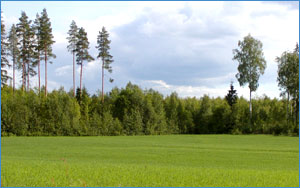 NB.
Today, quite the opposite is true. The beautiful landscapes and fields
of his homeland are located quite near the town of Jämijärvi,
approximately 40 minutes from Ikaalinen. NB.
Today, quite the opposite is true. The beautiful landscapes and fields
of his homeland are located quite near the town of Jämijärvi,
approximately 40 minutes from Ikaalinen. This area is a lovely example of the splendid Finnish countryside and is well traveled by visitors criss-crossing the country through the maze of roads that connect the various towns and cities north west of Tampere. |
|||||||||||||||||||||
| How did you begin your music study and why did you choose the accordion? | |||||||||||||||||||||
|
Lasse was the youngest
of three brothers and just 5 years old. He came from a big family of
which the father had already passed away. Times were very hard, and
as a youngster, they started to collect berries from the forest as a
way for the mother to try and gather a little bit of money so that they
could have enough to eat and maybe consider other non essential items. |
|||||||||||||||||||||
| Was your family musical and did your mother play an important part in your early music education? | |||||||||||||||||||||
| Lasse's brothers
started to practice and if there were ever some other players around,
they would observe how they played the accordion and copy them, so little
by little they learnt to play the instrument. Lasse was not supposed to touch the instrument and when the older brothers were at school, his mother put the instrument in a cabinet and locked it up with a key. However, while the brothers were at school, he secretly removed it from this 'locked' cabinet, and tested it. His mother turned a blind eye to this activity, and kept this a secret, not telling the older brothers that he was playing their prized accordion. Lasse imitated what the older brothers were doing with the accordion. His information was gathered by the above mentioned 'spying' and 'imitating'. His mother was musical as well, and since he was not able to learn everything by watching his brothers, she came to his assistance with his playing, and was also singing with him. Their house was by the road and often people passed by going to the market place, and even once in a while, a car went by. Sometimes there were musicians passing by as well, and one day three musicians who were on holiday passed by and arrived at their house and started to play. It was almost like a competition amongst the players to see who was playing the best. Lasse was sitting on the floor listening to this. Kai Kutti, one of the three, was particularly inspiring to him, and he figured out that Kai had some interesting tricks such as hitting the keyboard with his thumb for a rhythmic effect. He was also the most virtuoso of the three, and quickly became the favorite of Lasse. After performing, Kai noticed that Lasse was extremely interested in his playing, and so just gave his instrument over to Lasse to try. Kai was wondering if Lasse would dare to try and play it. Lasse took the accordion, gave it all he could for this performance and played a polka. His brothers were extremely surprised and wondering what was happening, as they still didn't know that Lasse had been secretly working on the accordion while they were at school. To their knowledge, Lasse had never so much as touched the accordion! |
|||||||||||||||||||||
| What are your earliest memories of performing? | |||||||||||||||||||||
| From
then on when guest came to the house and saw the accordion, and asked
if anyone could play it, the brothers pointed to Lasse and stated.. yes...
he can play something! The older brothers even started showing him off,
excited that their little brother could play so well... and this was the
beginning. From then on, Lasse was practicing and the older brothers were teaching what they knew and they started pushing him with a 'yes, we can do it ' attitude. Lasse made a little bit of money by playing for guests and visitors that were passing by the house, and from these very early days, he learnt the concept and value of working for money. |
|||||||||||||||||||||
| Tell us a little bit about your early days of performing with the accordion. | |||||||||||||||||||||
|
His oldest sister was living
in the city of Pori, by the west coast and was working as a servant
in a upper class family. Lasse was invited to visit his sister and to
bring his accordion. While there, he visited the town and played a little
bit around the town where he created some interest among the residents
who wondered who this young boy was, that was playing the accordion
so well. |
|||||||||||||||||||||
| Who was your first accordion teacher and what other teachers have influenced you? | |||||||||||||||||||||
| He
was completely self taught. At the time he was learning, it was common
to gather your information by just watching and observing others. He would check out other players and how they did things, and then try them on his own. He studied the actual music and notes such as theory, himself from a school music book. In general he would just get any information he could from where ever he could find it. |
|||||||||||||||||||||
| During your career, you have performed around the world. Tell us a little about these early times of your international concerts. | |||||||||||||||||||||
At
the 1959 Confederation Internationale des Accordeonistes (CIA) Coupe Mondiale
in New York City there was a gala concert and it was announced by one
of the adjudicators, that there was one more participant. The judge told
the audience that this one contestant had been practicing for two years,
but unfortunately had arrived at the Coupe Mondiale late, so asked them
if they thought they should let this candidate still play?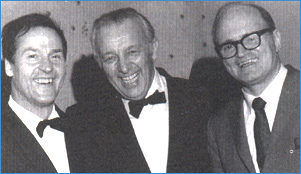 After
the audience agreed, Lasse walked out with a little accordion and played
his fantastic show number rendition of Dark Eyes and the audience went
wild. After this, Lasse switched to a big instrument and continued his
show. (Pictured in New York from left to right are Lasse, Pietro Deiro
and Charles Magnante.) After
the audience agreed, Lasse walked out with a little accordion and played
his fantastic show number rendition of Dark Eyes and the audience went
wild. After this, Lasse switched to a big instrument and continued his
show. (Pictured in New York from left to right are Lasse, Pietro Deiro
and Charles Magnante.)After this concert, Charles Magnante went to Lasse and told him that his place was to play in Radio City Music Hall in New York City, so they went there to audition and was immediately offered a job beginning in November of that year. He got this exciting initiation, but in 1957 he had already started his own Accordion Institute where he was responsible for teaching dozens of young students, so the timing was not right to leave, so in the end he didn't take the Radio City Music Hall job. Interestingly however, Lasse said that his very good friend and fellow accordionist, the late Mogens Ellegaard (1935-1995) was also interested in the Radio City Music Hall job, but his program was much more classical as opposed to Lasse's entertaining one, so in the end, neither ended up playing at Radio City Music Hall.  Lasse
returned to the USA in 1969 for a concert. That same year, the Coupe Mondiale
was once again held in New York City. Lasse
returned to the USA in 1969 for a concert. That same year, the Coupe Mondiale
was once again held in New York City.Matti Rantanen writes: outside Finland Lasse's main champion was the young Danish accordion wizard Mogens Ellegaard, who recalls getting to know Lasse Pihlajamaa and his music as outlined in the following statement: "I became the number-one Lasse Pihlajamaa fan the very first time I met him in Stockholm in 1952. What an incredible instrumentalist! What a warm and temperamental musician! What a fantastic accordion composer! And at the same time a world-class clown with his little Mickey Mouse accordion and his wicked "Dark Eyes". How fortunate I was to become friends with an artist I so infinitely admired! I imitated his style of playing as best I could and I had all his works in my repertoire. I even tried being a musical clown à la Lasse - but only twice, the first and last time! Above all, Pihlajamaa inspired me to work hard on my technique: not only with the thumb, the use of which I learnt from him, but with all ten fingers, and with music I hadn't had much to do with up till then." |
|||||||||||||||||||||
| Describe your most "unusual" or "humorous" performance situation/s? | |||||||||||||||||||||
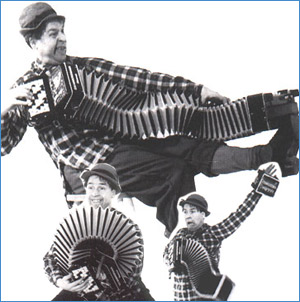 During
his long performing career, he has encountered a lot of interesting and
different performance situations but one came to mind. During
his long performing career, he has encountered a lot of interesting and
different performance situations but one came to mind.One time he was performing in Kemi a town up in the north of Finland, not quite in Lapland but close, at a pre Christmas celebration. He was performing his humorous show version of Dark Eyes with his small accordion with the extended bellows. On this instrument there was a mechanism the the bass end where he could push a button and the bass would detach. During this grand finale of the piece where this seperation of bellows and bass board occurred, he always jumped up in the air, and at this exact moment, the children hiding behind the stage props knocked everything over and it all came crashing down on his head. The audience thought this was all part of the show and were roaring with laughter, meanwhile, poor Lasse was lying on the stage covered in the props with a nail lodged in his head! Recounting another story, Lasse was in Carnegie Hall at the Coupe Mondiale and for a gala concert, he ended up with two tickets. The manager had arranged a ticket for him in one place, while the jury members had seats reserved in another place. Dressed in his white dinner jacket, by pure chance, he pulled out one of the two tickets and sat down. Shortly afterwards the man sitting next to him who was sick, threw up on his nice white dinner jacket and into his pocket, after which he had to endure this horrible smell, so he supposes that maybe this is the first time that someone has experienced such a thing in the famed Carnegie Hall! |
|||||||||||||||||||||
| Tell us about the Accordion Institute you founded in 1957 and some of the famous students that attended. | |||||||||||||||||||||
 Lasse
and Maire had already been married 15 years, and Maire said that Lasse
was always on tour and getting tired, so maybe it was enough time on the
road, and maybe it would be good for him to be finally home more. Lasse
and Maire had already been married 15 years, and Maire said that Lasse
was always on tour and getting tired, so maybe it was enough time on the
road, and maybe it would be good for him to be finally home more.  Additionally,
while on the tours, people would always ask him about his techniques,
and how he did this trick and that with his playing, since teaching studios
were not available at that time. Additionally,
while on the tours, people would always ask him about his techniques,
and how he did this trick and that with his playing, since teaching studios
were not available at that time. So, these two things motivated him to establish his own Accordion Institute, which was an instant success, attracting dozens and dozens of students in a very short amount of time. Pretty soon he found himself teaching all day long, and it was this commitment, that precluded him from taking such a job as was offered to him at Radio City Music Hall in New York City. |
|||||||||||||||||||||
| Among some of his well known students from his Accordion Institute are: | |||||||||||||||||||||
|
|||||||||||||||||||||
|
who all began their careers
there, and went on to win numerous prizes in international and national
competitions or have otherwise made a name for themselves in the music
world. In addition, Kari Lindquist, Kalervo
"Randy" Korlin, Raimo Rantanen have also made their name in
the music world. |
|||||||||||||||||||||
| I understand that you also wrote an accordion method book. How many books in all, and is it still available and used today? | |||||||||||||||||||||
 At
this time there were no studios and teaching methods to use, so when he
established his Accordion Institute, he began to put his teaching ideas
together and published his introductory teaching method book which was
used extensively at his Institute. At
this time there were no studios and teaching methods to use, so when he
established his Accordion Institute, he began to put his teaching ideas
together and published his introductory teaching method book which was
used extensively at his Institute. In those days, there were no copy machines so it was ideal to have such a book published to use for his teaching purposes. There is just one beginners book that was published. |
|||||||||||||||||||||
| When did you make your first recording? | |||||||||||||||||||||
 His
first recording was made in Stockholm in 1945 and between then and 1986
he recorded approximately 150 pieces and made dozens of recordings for
the Finnish Broadcasting Company (YLE). His
first recording was made in Stockholm in 1945 and between then and 1986
he recorded approximately 150 pieces and made dozens of recordings for
the Finnish Broadcasting Company (YLE).(YLE is Finland's national public service broadcasting company. YLE operates five national television channels and thirteen radio channels and services complemented by 25 regional radio programs.) |
|||||||||||||||||||||
| A major part of your accordion life has been devoted to composing. What was the first piece you composed and how old were you? | |||||||||||||||||||||
| He composed his first piece in 1935 called Sparkling Fountain. | |||||||||||||||||||||
| How many compositions have you written during your career? | |||||||||||||||||||||
|
|
|||||||||||||||||||||
|
|
|||||||||||||||||||||

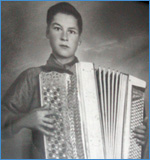
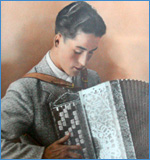


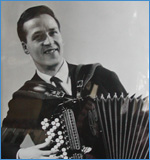
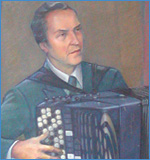
 At
that time, he said he was playing a very unusual way. He wasn't playing
like he played at home, instead much harder and rougher, but fortunately
two young children, a boy and a girl came to listen to his playing and
this small audience gave him some hope for his future!
At
that time, he said he was playing a very unusual way. He wasn't playing
like he played at home, instead much harder and rougher, but fortunately
two young children, a boy and a girl came to listen to his playing and
this small audience gave him some hope for his future! He
took Lasse to a second hand shop, where they found a beautiful 5 row
accordion and he asked Lasse to play it. Lasse had always played the
2 row diatonic instrument, but fortunately, had tested a 5 row instrument
at one time so was able to play one polka on this instrument and at
the end of this demonstration, the man bought Lasse this instrument,
his first 5 row accordion.
He
took Lasse to a second hand shop, where they found a beautiful 5 row
accordion and he asked Lasse to play it. Lasse had always played the
2 row diatonic instrument, but fortunately, had tested a 5 row instrument
at one time so was able to play one polka on this instrument and at
the end of this demonstration, the man bought Lasse this instrument,
his first 5 row accordion.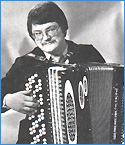
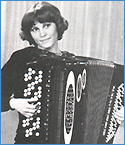
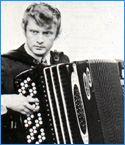

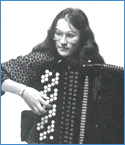
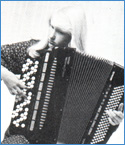
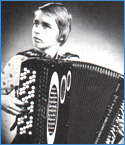
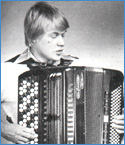
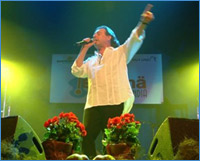 Other
students that have studied at Lasse's accordion Institute are the Finnish
pop singer Kirka (left) who according to his website enrolled in Lasse's
school in 1959 at the age of 9 years old, and the opera singer
Other
students that have studied at Lasse's accordion Institute are the Finnish
pop singer Kirka (left) who according to his website enrolled in Lasse's
school in 1959 at the age of 9 years old, and the opera singer
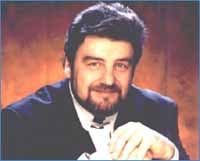 Raimo
Sirkiä (below right),
now Artistic Director of the Savonlinna Opera Festival.
Raimo
Sirkiä (below right),
now Artistic Director of the Savonlinna Opera Festival. During
his career he has composed more than 300 pieces.
During
his career he has composed more than 300 pieces.